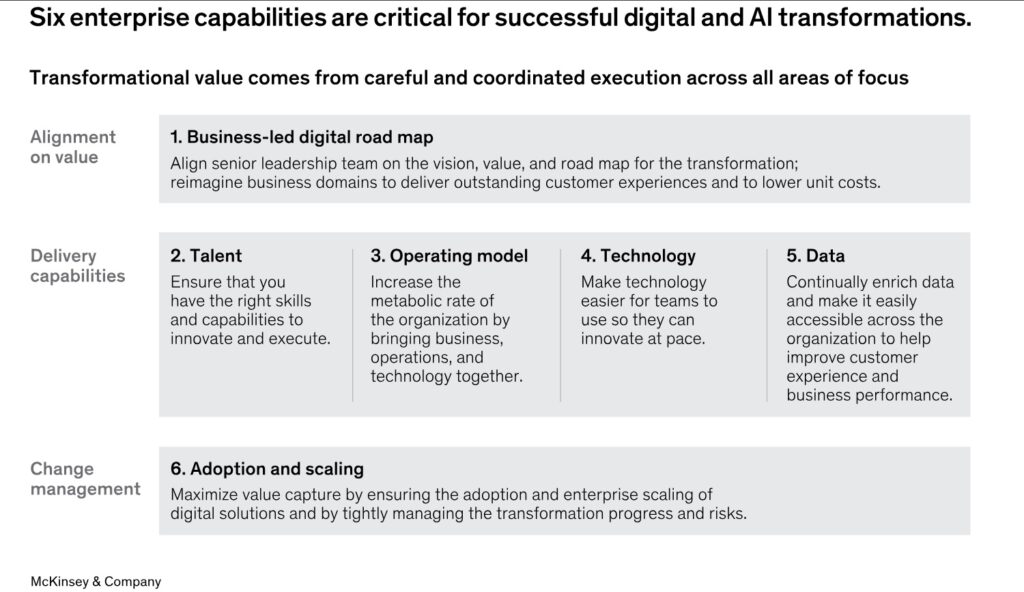“Design is Intelligence Made Visible” – Alina Wheeler
Summary: Building a strategy focused on fast-moving topics like AI requires a different approach. Assumptions are quickly proven false, and new ideas are introduced, causing our priorities to change. In Part 1, we discussed the need for a strategic AI intelligence stream to cut through the hype and understand market participants’ motivations. Part 2 explored enhancing ethics and risk management to address the unique challenges and opportunities AI presents. We also emphasized fostering a design mindset among lawyers and staff. In this final part, I will discuss the strategic design that enables the rapid pursuit of success in the AI world.
The Speed and Iterative Nature of AI Strategy
The availability of AI technology to non-technical professionals, such as lawyers and business leaders, has sparked creativity and accelerated strategic design cycles. The “gold rush” mentality surrounding generative AI compels organizations to act swiftly to stay competitive. And productivity gains witnessed in knowledge-based industries, including law, have the potential to reshape business models fundamentally. And while the AI hype may diminish over time, the momentum behind productivity gains will continue to grow stronger, establishing a new baseline. In summary, expect a faster strategic pace and be prepared to pivot more often.
Law Firm Leaders as Designers
To embark on this AI strategy journey, think of strategy as a design process. Embrace steps that foster creativity, adaptability, and continuous learning. As the renowned strategist Gary Hamel stated, “Strategy is not merely reacting to the future but actively shaping it.” Therefore, law firm leaders must adopt new thinking.[1]
Turbocharging The Traditional Law Firm Strategic Approach
The traditional law firm strategic approach starts with a situational assessment, examining market conditions, competitors, strengths, and culture. Your AI strategy expands on this in the following ways:
- Developing and Envisioning New Capabilities: Elevating the firm to a new playing field by envisioning an automated firm operating at a heightened state with data embedded throughout.
- Transforming the Business Model: Exploring how AI can accelerate current market strengths or develop new ones, affecting talent, pricing, and services.
Below is a visualization from McKinsey’s strategic design book, “Rewired,”[2] which describes the capabilities required to compete in the digital and AI age:

The “Rewired” framework focuses on developing organizational capabilities. In contrast, law firms typically emphasize individuals, experience, and expertise. The AI-enabled law firm combines these ideas to become a new market competitor.
For instance, consider the following scenario:
While boasting impressive achievements, a highly successful corporate practice in a midsize firm grapples with scaling challenges caused by overwhelmed practitioners and an ongoing struggle to attract top talent. Despite being tech-savvy, the practice’s aversion to embracing automation hampers its progress in streamlining operations and efficiency. Additionally, a noteworthy shortcoming is the need for more focus on optimizing the economics of their practice, which leaves potential growth opportunities untapped. Addressing these concerns with a renewed openness to automation and a strategic emphasis on the financial aspects could unlock value for the practice’s future success.
By adopting the framework, the practice might:
- Create a Business-Led Digital Roadmap, add a digital leader, create digital literacy, review service, and business workflows, examine client touchpoints, and leverage improved talent attraction strategies with accelerated automation to become more scalable and innovative.
- Enhance Talent Strategy by continuing to hire high-caliber associates but supplement with business-savvy automation experts. Push your teams to higher-value work.
- Implement an Automated Operating Model with new capabilities like automated practice workflows, document automation, and summarization to improve accuracy and speed, allowing pricing based on value rather than time, creating sticky monetization streams and client connections.
- Leverage Technology and Data to connect more seamlessly with key clients and create a competitive advantage with a data repository and reusable building blocks.
- Scale the Practice’s Capabilities, serve more clients, and accelerate profitability with a dynamic, continually evolving strategic platform.
Small Wins Make for Big Strategies
The above approach may initially appear daunting but remember that taking the first steps and engaging in experimentation is crucial to progress. I highly recommend adopting the principles of Atomic Habits,[3], where focusing on small, incremental changes can lead to significant momentum and occasional major achievements.[4] This will yield a powerful creative energy that will propel you forward by leveraging and combining your strengths with newfound abilities. Embrace the process and trust that consistent effort will deliver remarkable results.[5]
Other Approaches
The framework above is just one example. The critical point is recognizing the need to re-orient your strategic thinking and enhance or adopt a digital approach. Below are additional examples relevant to AI strategy:
- July 14, Harvard Business Review, “Building a Winning AI Strategy for Your Business” by Christopher Young — emphasizing experimentation, focusing on productivity gains, and creating transformative experiences for your clients
- July-August, Harvard Business Review, “What Smart Companies Know About Integrating AI” by Silvio Palumbo and David Edelman — discusses the criticality of incorporating talent and data with technology advances
- April 28, Medium, “The Three Stages of AI Adoption – Where are You?” by George Yates — describing integration levels with large language models in business workflows
- March 2023, BCG, “CEO’s Roadmap on Generative AI” — which walks the CEO through critical strategic and technological decisions organizations will need to make to deploy large language models
One of the best ways to utilize the mosaic of articles like those above is to assess your firm’s readiness to embrace new opportunities and stimulate your thinking with new ideas presented.
Summary
In this three-part series, I have proposed that AI strategy for law firms demands speed, adaptability, and a design mindset, being mindful of ethics and operating guard rails. By embracing AI’s transformative potential, you can shape your firm’s future in this rapidly evolving landscape.
I welcome your comments and ideas at mmedice@lawvision.com.
[1] Aug 2017, Medium, putting aside Elon Musk’s personal quirks, consider “Elon Musk’s ‘3-Step’ First Principles Thinking: How to Think and Solve Difficult Problems Like a Genius,” It emphasizes the process of re-evaluating assumptions, even those considered common knowledge, and using this fresh perspective to develop innovative solutions. By questioning and challenging established beliefs, “first principles” thinking allows individuals to avoid being constrained by traditional approaches and opens the door to creative problem-solving and strategic reorientation. This mindset encourages a deeper understanding of the core elements of a problem, paving the way for more effective and groundbreaking solutions.
[2] McKinsey. (2023). Rewired: The McKinsey Guide to Outcompeting in the Age of Digital and AI. John Wiley & Sons, Inc. Hoboken, NJ.
[3] James Clear. 2018. Atomic Habits: An Easy & Proven Way to Build Good Habits & Break Bad Ones. Publisher Avery.
[4] For example, I recently encountered an innovative AI platform that accelerates legal service delivery and promises productivity gains in the practice (callidusai.com). Leveraging tools like CallidusAI will create a familiarity with these technologies as well as inform the firm on ethics and compliance initiatives.
[5] For an example outside of legal, see this Barron’s article about “Why the AI Boom is Good for Microsoft, Risky for Chips and Server Makers” by Tae Kim, July 21, 2023. In the article it points out how aggressively Microsoft has embraced AI generally only to then pounce on its ability to monetize by introducing a premium $30 per month for its AI-enabled Microsoft 365 Copilot software, likely to generate billions of dollars in new AI revenue.
Posted In

